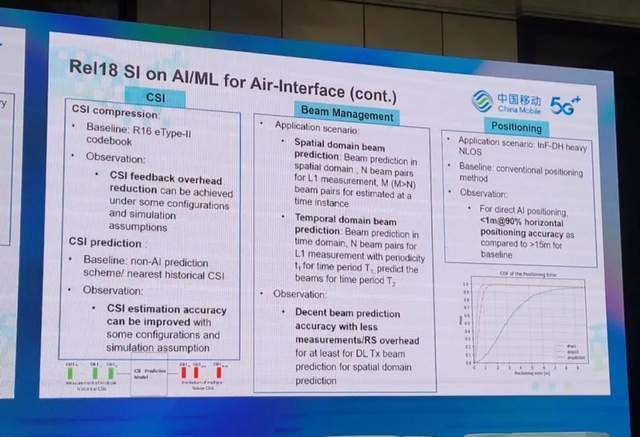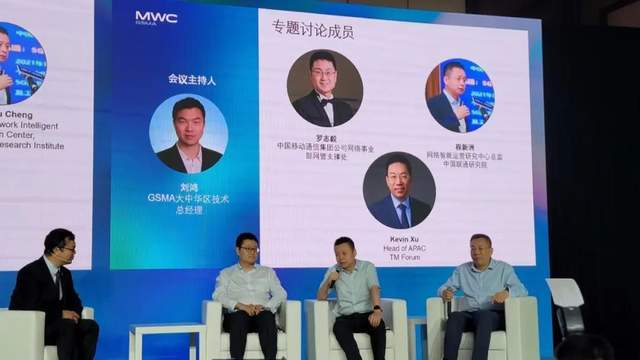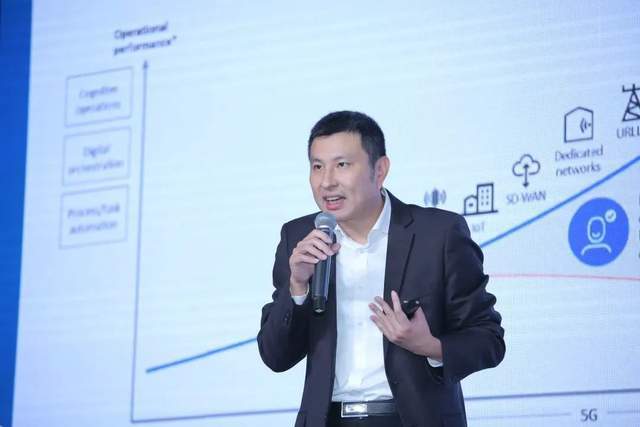 Technology peripherals
Technology peripherals
 AI
AI
 Review of MWC Shanghai: The era of AI large models has arrived. How will communication networks change?
Review of MWC Shanghai: The era of AI large models has arrived. How will communication networks change?
Review of MWC Shanghai: The era of AI large models has arrived. How will communication networks change?
At the "5G Future Summit" during MWC Shanghai 2023 last week, expert representatives from domestic telecom operators, equipment vendors and important industry associations shared the current application of AI technology in telecom networks, as well as the The model brings new possibilities to the entire industry. Experts attending the conference generally believed that the impact of large models is disruptive, especially for operators' network operation and maintenance and service delivery capabilities. However, how to realize the commercial realization of large AI models and expand the market pie in the future requires more discussion and open collaboration.

AI in Network standardization work is advancing steadily
Technological development, standards first. As one of the highlights of this forum, Xie Fang, technical manager and chief researcher of the Wireless and Terminal Technology Institute of China Mobile Research Institute, introduced in detail the AI/ML standardization research work carried out by 3GPP in R18. She said that currently 3GPP has four working groups conducting research on AI/ML standardization, including AI/ML for Air Interface, AI/ML for RAN, AI/ML for 5GS and AI/ML for OAM.
Specifically, in the current R18 AI/ML for Air Interface research project, there are three main types of training collaboration on the network device side and the user terminal side, one is no collaboration with each other (level x), and the other is There is signaling-based cooperation but no model transmission (level y), and there is signaling-based cooperation with model transmission (level z). At the same time, after the introduction of AI, a very important task is to study the general framework of life cycle management (LCM). In addition, 3GPP is currently focusing on three use cases in the R18 air interface project: CSI, beam management and positioning enhancement.

Xie Fang mentioned that the research on AI/ML for RAN in the R18 project is more clear, because in the R17 stage, three use cases (load balancing, mobility optimization and network energy saving) and functional framework have been studied. It needs to be clearer. Therefore, in this project, the main task of R18 is to specifically implement the enhancement of data collection and signaling based on the existing wireless network architecture.
In addition, AI/ML for 5GS is mainly about some enhancements to the core network after the introduction of AI. In this project, R18 mainly includes three aspects of work. The first is to further study the system enhancements based on NWDAF to allow 5GS Support network automation; the second is to further focus on some enhancements between network element functions of 5GC, with the main goal of supporting decision-making; the third is to further study the necessary inputs and outputs around NWDAF and potential architectural enhancements, new Scenes etc.
Finally, AI/ML for OAM is the earliest AI-related standardization research work carried out by 3GPP. It is mainly based on MDAS management data analysis services. Some major projects include closed-loop control, intent-driven management, self-intelligent network level, etc. .
When AI large models are introduced into self-intelligent networks
“Data, computing power, and models are the three essential elements for realizing AI, and communication networks are a natural and standard scenario that can provide these three elements. Therefore, the application of AI in the field of communication has always been It has been there since the beginning, but it’s just a question of how good it is.” Cheng Xinzhou, director of the Network Intelligent Operation Research Center of China Unicom Research Institute, said in the roundtable discussion that since the commercialization of 3G networks in 2009, the mobile Internet has developed rapidly, and data has shown explosive growth. The data provides a good space for deep learning. AI has since ushered in a great development, and AI achievements in the field of communication have also begun to increase.
He pointed out that before the emergence of large models, much of machine learning was first based on rules, and secondly required a large amount of data labeling. At the same time, many of them were trained in a single field and a single data source, so the ability to cross fields and multiple modalities was insufficient. This will result in many things not being able to be combined, making it difficult to solve complex, systematic projects. In addition, it is difficult to introduce things based on the accumulation of human cognitive experience into model training. The emergence of knowledge breakthroughs actually solves the problem of accumulation of expert experience to a certain extent, but it is static within a certain period of time and cannot be achieved in real time. renew. After the emergence of large models, intelligence truly emerged. It will learn autonomously and be able to achieve cross-domain multi-modality, thus subverting many things.
Cheng Xinzhou believes that the introduction of large AI models into autonomous networks will bring lower thresholds and higher efficiency, and breakpoints in data will be cleared one by one; at the same time, long-term accumulation of expert experience will be injected into the network Among them; in addition, future network maintenance, including operations and adapting to the dynamic needs of user scenarios, will become indistinguishable between humans and machines.

Luo Zhiyi, an expert at the Network Management Support Office of the Network Division of China Mobile Communications Group Corporation, agreed with the above point of view. He said that from the perspective of autonomous networks, first of all, the large model brings the ability to fully understand the network panorama, which is helpful for the multi-vendor management problems faced by telecom operators and the network collaboration and operation and maintenance problems at different levels. , which has brought about a reduction in learning costs and a jump in overall operation and maintenance capabilities. "With the help of large models, we hope to comprehensively and systematically sort out complex network knowledge, which will ultimately help us build real digital employees, through which we can quickly complete business delivery and network demarcation, thereby achieving overall operation and maintenance capabilities. I think this is a very important direction for GPT." At the same time, China Mobile hopes to use the large model's contextual association and understanding of natural language to achieve accurate translation of customer intentions, and then directly generate solutions and quickly automate them Configuration.
In summary, China’s largest telecom operator hopes to use AI large models to achieve cross-domain, cross-manufacturer, multi-complex system, and group knowledge graphs, and also hopes to form a more natural human-computer interaction. capabilities, thereby helping operation and maintenance personnel better manage the network.
What is the actual effect after the deep integration of AI and network?
As one of the world's leading communication equipment suppliers, Wu Riping, General Manager of Network Product Solutions of Ericsson China, shared Ericsson's current practical exploration and remarkable results in AI in Network at this forum. He said that mobile networks are becoming more and more complex and the amount of data processing is increasing. Both operators, equipment manufacturers and even end users hope that the maintenance costs of mobile networks represented by 5G will be reduced and the user experience will be improved. This has become a Ericsson introduces artificial intelligence into the core driving force of the entire communication network.
In Wu Riping’s view, the development of artificial intelligence in the field of communications is an evolution from manual, passive primary intelligence to data-driven, active advanced intelligence; if divided into three stages, the first stage The representative is script-based automated processing, the second stage is the introduction of data science technology of machine learning, and the third stage is intention-based artificial intelligence with cognitive capabilities, and Ericsson has successfully completed the first and second stages development and is now expanding its capabilities in the third phase.

He emphasized in his speech that to implement artificial intelligence in communication networks, the characteristics and requirements of the communication network need to be fully considered. In order to build AI capabilities in the professional communications field, Ericsson has built artificial intelligence in the communications field from three dimensions: network site, network platform, and API opening. Ericsson's AI is built on a solid foundation of deep telecom expertise combined with knowledge of data science and artificial intelligence. Ericsson has more than 1,000 multi-skilled experts with experience in telecommunications and data science, and has developed more than 200 AI use cases in the communications field; Ericsson's artificial intelligence platform processes more than 175TB of network data every day, and 65 million existing network users enjoy more benefits. Excellent network service.
Specific to practical results, in terms of network reliability, Ericsson has reduced operators’ site requirements by 20% through the use of artificial intelligence, achieved 100% accuracy in locating optical module faults, and reduced the number of faults by 33%. Necessary hardware replacement, etc. The improvement of network performance is the focus of artificial intelligence application in communication networks, playing a huge role in parameter tuning, problem location and improving user experience. In China, Ericsson’s AI power-saving platform assists operators in managing more than 90,000 5G base stations, with a power-saving effect of more than 20%. In addition, in optimizing uplink interference, Ericsson used artificial intelligence to automatically identify the interference effects of atmospheric waveguides and automatically implemented relief measures, which achieved good results.
To realize AI monetization still requires open collaboration
It is worth noting that Xu Junjie, regional director of TM Forum Asia Pacific, another industry expert who participated in this roundtable discussion, said that neither telecom operators nor equipment manufacturers may actually have enough resources to invest in universal Large model is being trained. Now everyone has reached a consensus that the general large model is not suitable for the telecommunications industry - because the general large model can only be learned from the Internet, it cannot learn the production data of operators. "I think China's three major operators have very good infrastructure, as well as suppliers such as Huawei and ZTE, which have participated in a large number of network constructions around the world. They also have the opportunity to access some actual production data of each operator. Relatively speaking, There are still opportunities to train some relatively easy-to-use large models. But for some small and medium-sized operators and small and medium-sized manufacturers, the opportunities are actually very limited, because without sufficient data and sufficient computing power, large models are It can't be done. This is a very real situation."
Xu Junjie mentioned that several domestic operators and equipment manufacturers are doing some practices of large models. But from the perspective of the entire industry, some reuse of large models should still be considered. But reuse involves opening up the model. So how to open up the models and let more people evaluate these models is actually a very important question. At the same time, including how to charge for the use of these open models and how to ensure a better business model, the industry needs to think about it.
In this regard, Luo Zhiyi believes, “In terms of business models, I think everyone needs to use the automation and intelligence capabilities in self-intelligent networks to empower the real economy and the country’s digital transformation development. In this new In the track, everyone can work together to make the cake bigger and jointly enhance the value of the entire industry. This may be a better model at present."
Cheng Xinzhou also said that enlarging the market pie is in line with the expectations of all parties. From this perspective, the bottom layer of the Digital China plan is connection and data elements, and these are precisely the two basic elements mastered by the communications industry (including operators and equipment manufacturers). Therefore, the future development of the communications industry is not just about its own development. However, the digital transformation of the entire society is inseparable from the empowerment of network connections and data elements. Analogous to the development trajectory of cloud companies, from the initial provision of hardware to the sale of many component plug-in services today, their development space is very broad. This space is not only in the IT field, but will radiate to the digitalization of the entire society. In the transformation, the pie of the entire market in the future will definitely be very big. In the future, the relationship between equipment manufacturers and operators may not be that of supply and use, but that of partners.
He said bluntly during the discussion, "The disruptive effect of large models may be no less than the spinning jenny of the first industrial revolution. Future business models cannot be imagined with the current organizational form. I think large models The emergence of is not the end, but a new starting point, the beginning of the beginning."
C114 Communication Network Ace
The above is the detailed content of Review of MWC Shanghai: The era of AI large models has arrived. How will communication networks change?. For more information, please follow other related articles on the PHP Chinese website!

Hot AI Tools

Undresser.AI Undress
AI-powered app for creating realistic nude photos

AI Clothes Remover
Online AI tool for removing clothes from photos.

Undress AI Tool
Undress images for free

Clothoff.io
AI clothes remover

AI Hentai Generator
Generate AI Hentai for free.

Hot Article

Hot Tools

Notepad++7.3.1
Easy-to-use and free code editor

SublimeText3 Chinese version
Chinese version, very easy to use

Zend Studio 13.0.1
Powerful PHP integrated development environment

Dreamweaver CS6
Visual web development tools

SublimeText3 Mac version
God-level code editing software (SublimeText3)

Hot Topics
 1375
1375
 52
52
 I Tried Vibe Coding with Cursor AI and It's Amazing!
Mar 20, 2025 pm 03:34 PM
I Tried Vibe Coding with Cursor AI and It's Amazing!
Mar 20, 2025 pm 03:34 PM
Vibe coding is reshaping the world of software development by letting us create applications using natural language instead of endless lines of code. Inspired by visionaries like Andrej Karpathy, this innovative approach lets dev
 Top 5 GenAI Launches of February 2025: GPT-4.5, Grok-3 & More!
Mar 22, 2025 am 10:58 AM
Top 5 GenAI Launches of February 2025: GPT-4.5, Grok-3 & More!
Mar 22, 2025 am 10:58 AM
February 2025 has been yet another game-changing month for generative AI, bringing us some of the most anticipated model upgrades and groundbreaking new features. From xAI’s Grok 3 and Anthropic’s Claude 3.7 Sonnet, to OpenAI’s G
 How to Use YOLO v12 for Object Detection?
Mar 22, 2025 am 11:07 AM
How to Use YOLO v12 for Object Detection?
Mar 22, 2025 am 11:07 AM
YOLO (You Only Look Once) has been a leading real-time object detection framework, with each iteration improving upon the previous versions. The latest version YOLO v12 introduces advancements that significantly enhance accuracy
 Google's GenCast: Weather Forecasting With GenCast Mini Demo
Mar 16, 2025 pm 01:46 PM
Google's GenCast: Weather Forecasting With GenCast Mini Demo
Mar 16, 2025 pm 01:46 PM
Google DeepMind's GenCast: A Revolutionary AI for Weather Forecasting Weather forecasting has undergone a dramatic transformation, moving from rudimentary observations to sophisticated AI-powered predictions. Google DeepMind's GenCast, a groundbreak
 Is ChatGPT 4 O available?
Mar 28, 2025 pm 05:29 PM
Is ChatGPT 4 O available?
Mar 28, 2025 pm 05:29 PM
ChatGPT 4 is currently available and widely used, demonstrating significant improvements in understanding context and generating coherent responses compared to its predecessors like ChatGPT 3.5. Future developments may include more personalized interactions and real-time data processing capabilities, further enhancing its potential for various applications.
 Which AI is better than ChatGPT?
Mar 18, 2025 pm 06:05 PM
Which AI is better than ChatGPT?
Mar 18, 2025 pm 06:05 PM
The article discusses AI models surpassing ChatGPT, like LaMDA, LLaMA, and Grok, highlighting their advantages in accuracy, understanding, and industry impact.(159 characters)
 o1 vs GPT-4o: Is OpenAI's New Model Better Than GPT-4o?
Mar 16, 2025 am 11:47 AM
o1 vs GPT-4o: Is OpenAI's New Model Better Than GPT-4o?
Mar 16, 2025 am 11:47 AM
OpenAI's o1: A 12-Day Gift Spree Begins with Their Most Powerful Model Yet December's arrival brings a global slowdown, snowflakes in some parts of the world, but OpenAI is just getting started. Sam Altman and his team are launching a 12-day gift ex
 How to Use Mistral OCR for Your Next RAG Model
Mar 21, 2025 am 11:11 AM
How to Use Mistral OCR for Your Next RAG Model
Mar 21, 2025 am 11:11 AM
Mistral OCR: Revolutionizing Retrieval-Augmented Generation with Multimodal Document Understanding Retrieval-Augmented Generation (RAG) systems have significantly advanced AI capabilities, enabling access to vast data stores for more informed respons



